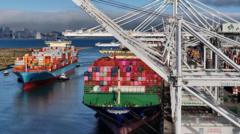US President Donald Trump's newly implemented tariffs on more than 90 countries are now taking effect, marking a substantial shift in the landscape of global trade. Announced initially in April but delayed due to market volatility, these tariffs, aimed at discouraging imports and encouraging domestic manufacturing, have created ripples throughout the international community.
Trump showcased his renewed tariff strategy by revealing on social media that the U.S. is experiencing an influx of revenue from these import taxes. He has aggressively framed tariffs as a mechanism to stimulate job growth and revive American manufacturing. Notably, he has threatened a dramatic increase in tariffs on imports from India to 50% unless the nation ceases its oil purchases from Russia, amid ongoing geopolitical tensions.
The tariffs, which apply a range of rates depending on the country and product category, have been particularly severe on Southeast Asian economies heavily reliant on exports. For instance, Laos and Myanmar face a staggering 40% levy, while Taiwan’s goods will incur a 20% tax. Analysts suggest that Trump’s approach seems particularly directed at nations with substantial trade connections to China.
Some experts, however, perceive this as a necessary step towards stabilizing trade after months of uncertainty. Economists like Bert Hofman have expressed that the U.S. markets seem temporarily resilient, with stock indices in places like Japan and South Korea recovering slightly, despite fears of increased volatility.
Negotiations have unfolded on several fronts to mitigate these tariffs. Major economies such as the UK, Japan, and South Korea have secured terms for lower rates, while the European Union has accepted a 15% tariff position in a bid to shield their exports to the U.S. On the flip side, Switzerland is grappling with a high 39% tariff that poses significant threats to its economic health.
Furthermore, the complexities of these tariffs have intertwined with ongoing U.S. relations surrounding the crisis in Ukraine. Trump's threatened penalties on countries trading with Russia have raised concerns that these moves might lead to a broader geopolitical fallout.
As negotiations between Washington and key trading partners continue, the ramifications of these tariffs could reshape future economic interactions on a global scale. With reactions from affected nations ranging from resistance to diplomatic engagements, the long-term impact on international trade remains closely watched as businesses and economies navigate this turbulent terrain.



















